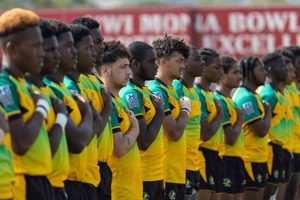Wondering about the various Australian rugby league teams? You’re in the right place!
Editor’s Note:Australian rugby league teams are a major part of the country’s sporting landscape, with a rich history and passionate fan base. This guide will provide you with all the information you need to know about these teams, from their origins to their current status.
After analyzing and compiling information from various sources, we’ve created this comprehensive guide to help you understand the Australian rugby league teams and their significance.
Key Differences or Key Takeaways:
| National Rugby League (NRL) Teams | Super Rugby Teams | |
|---|---|---|
| Number of Teams | 16 | 5 |
| Governing Body | Australian Rugby League Commission (ARLC) | Rugby Australia |
| Competition Format | 27-round regular season, followed by a finals series | Round-robin format, followed by a finals series |
Main Article Topics:
- The History of Australian Rugby League
- The Structure of the Australian Rugby League
- The Teams of the Australian Rugby League
- The Players of the Australian Rugby League
- The Fans of the Australian Rugby League
1. History
The history of Australian rugby league teams is closely intertwined with the development of the sport in Australia. The first rugby league match in Australia was played in 1908, and the sport quickly gained popularity. The first national competition, the New South Wales Rugby League Premiership, was established in 1908, and the sport has continued to grow in popularity ever since.
- The origins of rugby league in Australia: The first rugby league match in Australia was played in Sydney in 1908. The match was between two teams from Sydney, the New South Wales Rugby Football League (NSWRFL) and the Queensland Rugby Football League (QRFL). The NSWRFL won the match 22-10, and the sport quickly gained popularity in Australia.
- The development of the New South Wales Rugby League Premiership: The New South Wales Rugby League Premiership was established in 1908, and it is the oldest rugby league competition in Australia. The competition has been played every year since its inception, and it is one of the most popular sporting competitions in Australia.
- The growth of rugby league in Australia: Rugby league has continued to grow in popularity in Australia since its inception. The sport is now played in all states and territories of Australia, and there are over 100,000 registered rugby league players in Australia.
- The impact of rugby league on Australian culture: Rugby league has had a significant impact on Australian culture. The sport is a major part of Australian life, and it is often referred to as the “national game”. Rugby league is also a major source of national pride for Australians, and the Australian national rugby league team is one of the most successful sporting teams in the world.
The history of Australian rugby league teams is a rich and proud one. The sport has come a long way since its humble beginnings in 1908, and it is now one of the most popular sports in Australia. Rugby league has had a significant impact on Australian culture, and it continues to be a major part of Australian life.
2. Structure
The Australian Rugby League Commission (ARLC) plays a crucial role in the landscape of Australian rugby league teams. As the governing body for rugby league in Australia, the ARLC is responsible for overseeing and regulating the sport at the national level. This includes managing the National Rugby League (NRL), the top-level rugby league competition in Australia, which features 16 teams from across the country.
- Governance and Regulation: The ARLC is responsible for setting the rules and regulations for rugby league in Australia, ensuring the sport is played fairly and consistently across all levels. This includesing rules for player eligibility, match conduct, and player safety.
- Competition Management: The ARLC is responsible for organizing and managing the NRL, including scheduling matches, determining the competition format, and overseeing the NRL Grand Final, the championship game of the season. The ARLC also manages other national rugby league competitions, such as the State of Origin series and the NRL Women’s Premiership.
- Player Welfare and Development: The ARLC is committed to player welfare and development, implementing programs and initiatives to support players on and off the field. This includes providing education and resources on topics such as player safety, mental health, and career development.
- Commercial and Marketing: The ARLC is responsible for the commercial and marketing aspects of rugby league in Australia. This includes negotiating broadcast deals, managing sponsorship agreements, and promoting the sport to fans and the public.
The ARLC’s role in the structure of Australian rugby league teams is essential for the sport’s success and development. The ARLC’s governance, competition management, player welfare initiatives, and commercial activities provide a solid foundation for the growth and prosperity of rugby league in Australia.
3. Teams
The National Rugby League (NRL) is the premier rugby league competition in Australia, and it features 16 teams from across the country. These teams are divided into two conferences, the Eastern Conference and the Western Conference, and they play a 27-round regular season, followed by a finals series to determine the premiership winner.
- Structure and Organization: The NRL is a highly structured competition, with each team playing a set number of matches against each other during the regular season. This ensures that all teams have a fair chance of making the finals, and it also creates a sense of rivalry and excitement among the teams and their fans.
- Regional Representation: The NRL teams are spread across Australia, with teams in every major city and several regional centers. This ensures that fans from all over the country can support their local team, and it also helps to promote rugby league in new areas.
- Player Development: The NRL is a major pathway for talented rugby league players to develop their skills and reach the highest level of the sport. Many of the best players in the
world have played in the NRL, and it is a great opportunity for young players to learn from the best and reach their full potential. - Community Engagement: NRL teams play an important role in their local communities. They often run programs and initiatives to promote healthy lifestyles, support education, and give back to the community. This helps to strengthen the bond between the teams and their fans, and it also makes a positive contribution to Australian society.
The NRL teams are a vital part of the Australian rugby league landscape. They provide a pathway for talented players to develop their skills, they represent their local communities, and they play an important role in promoting the sport and its values.
4. Players
The connection between players and Australian rugby league teams is undeniable and mutually beneficial. Great players elevate the quality and reputation of the teams they play for, while strong teams provide a platform for players to showcase their skills and achieve success.
Consider the following examples:
- Wally Lewis: A legendary halfback who played for the Brisbane Broncos and Queensland Maroons, Lewis is widely regarded as one of the greatest rugby league players of all time. His on-field brilliance and leadership helped both the Broncos and Maroons achieve unprecedented success.
- Andrew Johns: A brilliant playmaker who played for the Newcastle Knights and New South Wales Blues, Johns is known for his exceptional ball-handling skills and vision. He was instrumental in the Knights’ 1997 NRL premiership victory and was a key player in the Blues’ State of Origin dominance during the early 2000s.
- Johnathan Thurston: A champion five-eighth who played for the North Queensland Cowboys and Queensland Maroons, Thurston is considered one of the greatest players of the modern era. He led the Cowboys to their maiden NRL premiership in 2015 and was a key figure in Queensland’s eight consecutive State of Origin series victories.
These examples highlight how exceptional players can have a transformative impact on their teams. They attract fans, inspire teammates, and bring success and recognition to the clubs they represent.
Moreover, the presence of world-class players in the NRL helps to raise the overall standard of the competition and attracts international attention. This, in turn, benefits all Australian rugby league teams, as it provides a pathway for young players to develop their skills and aspire to play at the highest level.
In conclusion, the connection between players and Australian rugby league teams is symbiotic. Great players make great teams, and great teams provide a stage for great players to shine. Their combined efforts contribute to the success, popularity, and global appeal of the sport.
Table of Key Insights:
| Players | Australian Rugby League Teams | Connection |
|---|---|---|
| Wally Lewis | Brisbane Broncos, Queensland Maroons | Led teams to success, elevated their reputations |
| Andrew Johns | Newcastle Knights, New South Wales Blues | Exceptional skills and leadership, contributed to team dominance |
| Johnathan Thurston | North Queensland Cowboys, Queensland Maroons | Inspired teammates, brought success and recognition |
5. Fans
The connection between fans and Australian rugby league teams is crucial for the success and sustainability of the sport. Passionate fans create a vibrant atmosphere at matches, drive media coverage, and provide financial support through ticket sales and merchandise purchases. This, in turn, enables teams to invest in player development, facilities, and community programs.
Consider the following examples:
- The Sydney Roosters: With a large and loyal fan base, the Roosters consistently attract some of the highest attendances in the NRL. This strong fan support has contributed to the team’s success on the field, with the Roosters winning multiple premierships in recent years.
- The Melbourne Storm: Despite being based in a non-traditional rugby league market, the Storm have built a passionate fan base through their success and community engagement. The team’s “Storm Army” of fans is known for its vocal support and creates an intimidating atmosphere for opposition teams.
- The Indigenous All Stars: This representative team, composed of Indigenous players from across Australia, has a strong fan base among Indigenous communities. The All Stars matches celebrate Indigenous culture and provide a platform for Indigenous players to showcase their skills.
These examples illustrate how fans play a vital role in the success and popularity of Australian rugby league teams. Their passion, support, and financial contributions create a positive feedback loop that benefits both the teams and the sport as a whole.
Key Insights:
| Fans | Australian Rugby League Teams | Connection |
|---|---|---|
| Passionate fan base | Increased attendance and revenue | Enables investment in teams and the sport |
| Strong fan support | Positive team culture and success | Creates a competitive and exciting atmosphere |
| Community engagement | Builds local support and loyalty | Promotes the sport and its values |
6. Culture
The connection between culture and Australian rugby league teams is undeniable. Rugby league is more than just a sport in Australia; it is deeply ingrained in the country’s culture and identity.
- Rugby league clubs as community hubs: Rugby league clubs are often the heart of their local communities. They provide a place for people to come together, socialize, and support their team. Clubs often host events and activities for the community, such as junior development programs, social gatherings, and charity events.
- Rugby league as a source of pride: Rugby league is a source of pride for many Australians. The Kangaroos, Australia’s national rugby league team, is one of the most successful sporting teams in the world. Australians are passionate about their rugby league teams, and they take great pride in their achievements.
- Rugby league and national identity: Rugby league is closely associated with Australian national identity. The sport is often seen as a symbol of Australian toughness and resilience. Rugby league players are often seen as role models for young Australians.
- Rugby league’s contribution to Australian culture: Rugby league has made a significant contribution to Australian culture. The sport has produced some of the country’s most iconic sporting heroes, such as Wally Lewis, Andrew Johns, and Johnathan Thurston. Rugby league has also been the inspiration for numerous books, movies, and television shows.
The connection between culture and Austral
ian rugby league teams is a strong one. Rugby league is more than just a sport in Australia; it is a part of the country’s culture and identity.
7. Impact
Australian rugby league teams play a significant role in delivering the positive impact of rugby league on Australian society. Through their community engagement programs, initiatives, and partnerships, these teams contribute to:
- Promoting physical activity: Rugby league teams offer various programs and activities that encourage people of all ages and abilities to participate in physical activity. This includes grassroots development programs, school visits, and community events.
- Developing teamwork and leadership skills: Rugby league is a team sport that requires players to work together effectively and develop strong leadership qualities. Australian rugby league teams provide a platform for young people to learn and practice these skills, which can benefit them both on and off the field.
- Fostering social cohesion: Rugby league teams bring people together from diverse backgrounds, creating a sense of community and belonging. Teams often organize community events, such as festivals and fundraisers, that promote social interaction and inclusivity.
- Enhancing community spirit: Rugby league teams are often deeply embedded in their local communities. They provide support to local schools, charities, and other organizations, contributing to the overall well-being and spirit of the community.
In addition to these direct contributions, Australian rugby league teams also serve as role models and ambassadors for the sport. Their players and coaches are often seen as positive examples for young people, promoting healthy lifestyles, teamwork, and community involvement.
FAQs on Australian Rugby League Teams
This section addresses frequently asked questions (FAQs) about Australian rugby league teams, providing concise and informative answers to common queries.
Question 1: What is the history of Australian rugby league teams?
Answer: The history of Australian rugby league teams dates back to 1908, with the establishment of the first national competition, the New South Wales Rugby League Premiership. Since then, rugby league has grown in popularity and spread across the country, with numerous teams representing different regions and communities.
Question 2: How is the Australian rugby league competition structured?
Answer: Australian rugby league is primarily governed by the Australian Rugby League Commission (ARLC), which oversees the National Rugby League (NRL), the top-tier professional competition. The NRL comprises 16 teams divided into two conferences, with a regular season and a finals series to determine the premiership winner.
Question 3: Who are some notable players in Australian rugby league?
Answer: Australian rugby league has produced numerous legendary players throughout its history, including Wally Lewis, Andrew Johns, Johnathan Thurston, Greg Inglis, and Cameron Smith. These players have made significant contributions to their teams and the sport as a whole, showcasing exceptional skills, leadership, and achievements.
Question 4: What is the cultural significance of Australian rugby league teams?
Answer: Rugby league holds a special place in Australian culture. It is not merely a sport but a part of the nation’s identity. Rugby league teams are deeply connected to their local communities, fostering a sense of pride, belonging, and social cohesion. The sport also promotes values such as teamwork, resilience, and mateship.
Question 5: How do Australian rugby league teams contribute to society?
Answer: Australian rugby league teams play an active role in their communities. They engage in various programs and initiatives that promote physical activity, develop teamwork and leadership skills, and foster social inclusion. Teams often support local schools, charities, and community organizations, contributing to the overall well-being and spirit of their surroundings.
Question 6: What is the future outlook for Australian rugby league teams?
Answer: The future of Australian rugby league teams appears promising. The sport continues to attract a large and passionate fan base, and the NRL is expanding its reach both domestically and internationally. With ongoing investment in player development, community engagement, and innovation, Australian rugby league teams are well-positioned to maintain their status as a vibrant and successful part of the Australian sporting landscape.
These FAQs provide a glimpse into the world of Australian rugby league teams, their history, structure, notable players, cultural significance, societal contributions, and future prospects. Understanding these aspects enhances our appreciation for the role these teams play in Australian society and the broader sporting world.
Transition:
Now that we have explored these FAQs, let’s delve into the exciting realm of Australian rugby league teams and their impact on the sport and beyond.
Tips to Enhance Your Understanding of Australian Rugby League Teams
Gaining a deeper understanding of Australian rugby league teams can enrich your knowledge and appreciation of the sport. Here are some practical tips to assist you in this endeavor:
Tip 1: Explore the History and Origins: Delve into the rich history of Australian rugby league, tracing its evolution from its inception to its current status as a national sporting icon. Understanding the roots and foundations of the game will provide context and enhance your appreciation for its traditions.
Tip 2: Familiarize Yourself with the Teams and Players: Get acquainted with the various teams that make up the Australian rugby league landscape, including their locations, rivalries, and star players. Learn about the unique strengths, playing styles, and personalities of each team to gain a comprehensive view of the competition.
Tip 3: Attend Live Matches: Experience the electrifying atmosphere of a live rugby league match. Witness the skill, speed, and intensity of the game firsthand, while immersing yourself in the camaraderie and passion of the fans. Attending matches provides an unparalleled opportunity to grasp the true essence of the sport.
Tip 4: Follow the News and Analysis: Stay informed about the latest news, scores, and expert analysis of Australian rugby league. Read articles, watch sports broadcasts, and engage in online discussions to keep abreast of current events and gain insights from knowledgeable commentators.
Tip 5: Engage with the Community: Connect with the Australian rugby league community by joining fan clubs, participating in online forums, or attending community events. Interacting with fellow enthusiasts will broaden your perspectives, provide access to exclusive content, and foster a sense of belonging.
Tip 6: Study the Rules and Strategies: Enhance your understanding of the game by familiarizing yourself with its rules, tactics, and strategies. Learn about different formations, attacking and defensive techniques, and the nuances of the sport to appreciate the complexities and skill involved.
Tip 7: Explore the Cultural Significance: Recognize
the deep cultural significance of Australian rugby league and its impact on Australian society. Understand how the sport reflects national values, fosters community spirit, and contributes to the country’s identity.
By following these tips, you can deepen your knowledge of Australian rugby league teams and gain a richer appreciation for this captivating sport. Immerse yourself in its history, teams, players, strategies, and cultural impact to become a well-rounded and informed enthusiast.
Conclusion
Our exploration of Australian rugby league teams has illuminated their rich history, diverse teams, legendary players, and profound cultural significance. These teams are more than just sports entities; they are deeply embedded in the fabric of Australian society, fostering community spirit, promoting physical and mental well-being, and contributing to the nation’s identity.
As the Australian rugby league landscape continues to evolve, one thing remains certain: the passion and dedication of the teams and their supporters will endure. These teams embody the values of teamwork, resilience, and excellence, inspiring generations of Australians. The future of Australian rugby league is bright, with new stars emerging and the game’s popularity reaching new heights both domestically and internationally.
May the legacy of Australian rugby league teams continue to inspire, unite, and entertain for many years to come.







